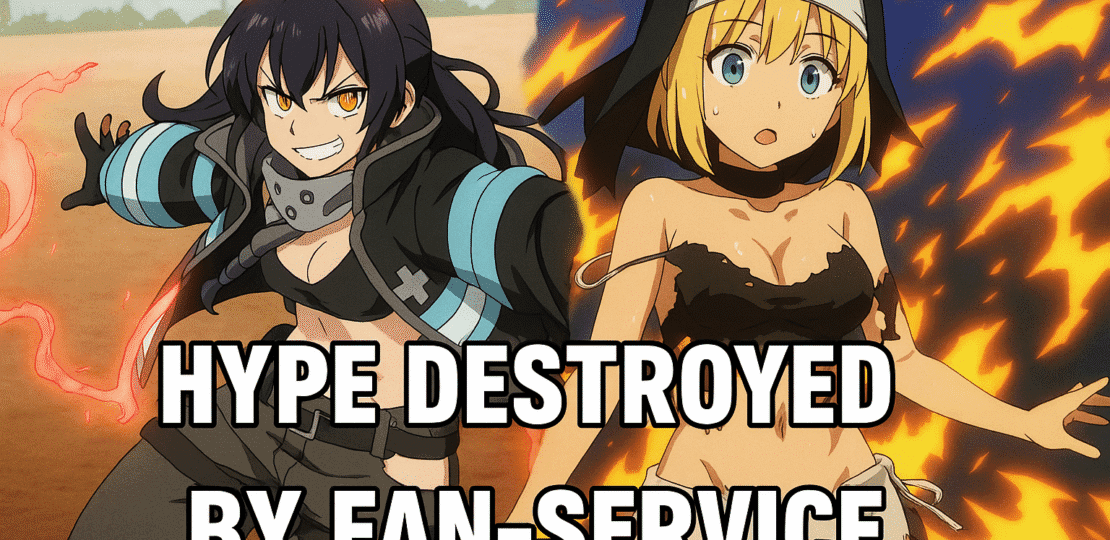
Fire Force, created by Atsushi Ohkubo, is a shonen anime set in a post-apocalyptic Tokyo where humans spontaneously combust into fiery monsters called Infernals. The story follows Shinra Kusakabe, a young firefighter with the ability to ignite his feet for superhuman speed, as he joins Special Fire Force Company 8 to battle these threats and uncover a conspiracy tied to his family’s tragic past. Across three seasons, the series blends high-stakes action, mystery, and supernatural elements, exploring themes of faith, corruption, and heroism. However, its reputation is complicated by pervasive fan service, which many argue clashes with the narrative’s serious undertones.
Defining Fan Service in the Context of Fire Force
Fan service refers to elements designed to appeal to viewers through sexualized content, such as revealing outfits, accidental nudity, or suggestive poses. In Fire Force, this manifests prominently through characters like Tamaki Kotatsu, whose “curse” leads to frequent compromising situations. While common in anime, the implementation here is often criticized for feeling forced and irrelevant, especially in a story about life-or-death firefighting.
Key Reasons Fan Service Detracts from the Experience
The primary issue seems to be tonal inconsistency: fan service interrupts dramatic scenes, like battles or emotional revelations, shifting focus from plot to titillation. This can make characters, especially women, feel underdeveloped—reduced to objects rather than heroes. For instance, Tamaki‘s potential as a skilled pyrokinetic is overshadowed by repetitive gags, leading viewers to question the series’ priorities. Broader impacts include alienating audiences uncomfortable with such content, potentially limiting the show’s appeal despite its innovative animation and lore.
In the vibrant yet tumultuous world of anime, few series encapsulate the highs and lows of shonen storytelling quite like Fire Force. Crafted by Atsushi Ohkubo, the mind behind Soul Eater, this anime burst onto the scene in 2019 with a premise that promised adrenaline-fueled action, intricate world-building, and a dash of supernatural intrigue. Set in Year 198 of the Solar Era in an alternate Tokyo ravaged by a cataclysmic event known as the Great Cataclysm, humanity grapples with a terrifying phenomenon: Spontaneous Human Combustion. Ordinary people burst into flames, transforming into rampaging Infernals—mindless, fiery beasts that threaten society. To combat this, the Tokyo Empire establishes the Special Fire Force, elite squads of pyrokinetics who extinguish these threats while upholding the faith in the Holy Sol Temple, a religion centered on the sun god.
The protagonist, Shinra Kusakabe, is a Third Generation pyrokinetic with the unique ability to propel himself at rocket-like speeds by igniting his feet, earning him the moniker “Devil’s Footprints.” Haunted by a childhood fire that claimed his mother and brother—blamed on him due to his powers—Shinra joins Company 8, a ragtag unit tasked with not only fighting Infernals but also investigating the corruption festering within the Fire Force and the empire. His journey uncovers a vast conspiracy involving artificial Infernals, the enigmatic White-Clad cult, and the ancient secrets of the Adolla Burst, a pure flame linking to another dimension. Seasons progress from localized missions to global stakes, with alliances forming and betraying, battles escalating in scale, and revelations peeling back layers of deceit.
Season 1 introduces the core team: the laid-back captain Akitaru Ōbi, the devout nun Iris, the muscle-bound witch Maki Oze, the analytical Takehisa Hinawa, and others. Episodes like “The Heart of a Fire Soldier” and “The Spreading Malice” build tension through rookie games, infernal outbreaks, and initial clashes with antagonists like Rekka Hoshimiya, a corrupt priest from Company 1. The animation by David Production shines in fluid fight choreography, with flames dancing vividly across the screen. By Season 2, the plot delves deeper into the Netherworld arc, where Company 8 infiltrates underground realms, facing off against the White-Clad’s evangelists and discovering links to the Pillars—individuals with the Adolla Burst. Arcs like the Chinese Peninsula expedition introduce global elements, blending espionage with explosive confrontations.
Season 3, premiering in April 2025, ramps up the apocalypse, with episodes such as “Indomitable Resolve” and “The Great Kaiju Battlefront” focusing on imprisonment, incarnations of flame, and madness from the distant past. Themes of resolve and truth dominate, as Shinra confronts arch-enemies and unravels the empire’s foundations. The series’ strengths lie in its innovative power system—generations of pyrokinetics with evolving abilities—and its critique of blind faith, corruption, and human nature. Yet, woven throughout this tapestry is a persistent thread that many argue unravels the whole: fan service.
At the heart of the controversy is Tamaki Kotatsu, a 17-year-old Third Generation pyrokinetic initially from Company 1. Her background is tragic yet motivational: ostracized in school for her clumsiness, she awakens her powers during a moment of desperation, sprouting fiery cat tails that inspire her to join the Fire Force under the guidance of Rekka. Tamaki‘s abilities, dubbed “Nekomata,” envelop her in pink flames, granting cat-like agility, claws, and tails for propulsion and restraint. She can generate fire blasts, run on all fours for enhanced speed, and even evolve to form a full-body flame cat suit, making her a formidable fighter against Infernals and foes like Assault or Orochi. Her durability allows survival against brutal attacks, and her speed dodges from powerhouses like Rekka.
Personality-wise, Tamaki is a mix of friendliness and bravado. She’s kind to children and allies, forming bonds across companies, but her boastfulness masks deep insecurities about her strength and purpose. She joined the Fire Force without a clear calling, leading to moments of doubt and anger. Courageous at her core, she defies superiors when justice demands, like exposing Rekka‘s villainy. Tsundere traits emerge in interactions with Shinra, hinting at unspoken affection. However, her defining trait—the “Lucky Lecher Lure”—casts a long shadow over her arc.
This “syndrome” is a contrived curse causing Tamaki to stumble into humiliating, sexualized scenarios: clothes mysteriously vanish, she falls into groping positions, or lands seductively on others. Blamed on bad luck, it embarrasses her endlessly, often eliciting frustration or tears. While intended as comedy, it pigeonholes her as a punchline, stunting growth. In the Introduction Arc’s Rookie Games, she grapples with Shinra only to be groped, fueling her competitive fire but underscoring clumsiness. The VS. 1st Brigade Arc sees her clothes burned off post-Rekka‘s assault, leaving her in undergarments while encouraging Shinra—a mix of vulnerability and resolve.
The Preacher Pursuit Arc has her naked under an apron during dinner prep, pushing her back to duty amid embarrassment. In Asakusa, her top flies off during repairs, smooshing against Shinra. The Netherworld Arc turns mishap to advantage: falling on Assault, her jacket snags, aiding victory with Iris. Operation Nether sees calm amid syndrome triggers, analyzing threats before saving allies. These moments evolve her from insecure to resilient, but critics argue they undermine seriousness, reducing a justice-driven soldier to objectification.
Beyond Tamaki, fan service permeates the series. Maki Oze, a powerful witch with flame manipulation, endures groping in chases, her badassery clashing with guy-obsession tropes. Iris, the pious nun, appears naked in showers discussing romance, jarring against her soul-ushering role. Hibana, a commanding figure, uses sexualization as empowerment, but even she fits the pattern of revealing outfits and angles. Male characters like Ōbi get occasional nods—nude calendars—but it’s disproportionately female-focused, with impractical uniforms like Tamaki‘s bikini top ill-suited for firefighting.
Compilations reveal the extent: Season 1 features Tamaki‘s lure in simulations, fights, and casual moments, like tripping into embraces. Season 2 escalates in the Nether, with clothes-shredding falls during infernal hunts. Season 3’s premiere continues the trend, with Tamaki slipping post-training, nudity undercutting growth. Videos and threads catalog these as disruptive— a high-tension battle ends with boob-grabs, or emotional cries follow lecherous tumbles.
Criticisms abound. Articles describe fan service as outdated, demeaning, and embarrassing, reducing women to vulgarity. One analysis notes it disrupts tone: a tense doppelganger encounter devolves into stripping, killing immersion. Another calls Tamaki‘s quirk “disgusting,” limiting her from “truly interesting” to damsel. Discussions highlight quantity—multiple per episode—and timing, interrupting stakes like city repairs or infernal defeats. It objectifies, especially with underage implications, and reflects authorial fetishes over story needs.
Fan opinions echo this: Reddit threads lament forced quantity breaking serious moments, making recommendations tricky. X posts decry it as “corny,” “unwatchable,” or “nerfing” potential, comparing to Fairy Tail‘s drop-off. Some feel it alienates, with viewers dropping early despite “peak story.” Counterarguments exist: it’s comedic relief, critiques slut-shaming via Tamaki‘s discomfort, or fits anime norms. Defenders argue removal would spark complaints, and it’s faithful to manga. Yet, consensus leans critical—fan service holds back viewership, tarnishing reputation despite compelling intrigue.
Comparisons illuminate issues. Soul Eater, by the same creator, has fan service but integrates better, like Blair’s playful sexuality without derailing plots. My Hero Academia balances ecchi minimally, focusing on heroism. High School DxD embraces it as core, but Fire Force‘s hybrid—serious lore with intrusive gags—creates dissonance. Tables below organize details:
Fan Service Instances by Season (Selected Examples)
| Season | Episode/Arc | Instance Description | Impact on Scene |
|---|---|---|---|
| 1 | Rookie Games | Tamaki groped stopping Shinra; clothes partially removed. | Undermines competitive tension; shifts to humor. |
| 1 | VS. 1st Brigade | Post-fight fall burns Tamaki‘s clothes; seductive pose on Shinra. | Distracts from emotional encouragement; adds embarrassment. |
| 2 | Netherworld | Jacket snag on Assault leads to exposure; aids win inadvertently. | Turns battle aid into lewd gag; mixed utility. |
| 2 | Asakusa Repairs | Top flies off; breasts in Shinra‘s face. | Ruins post-battle recovery; focuses on body over teamwork. |
| 3 | Episode 1 | Slips after training; full nudity. | Negates development; reinforces quirk over growth. |
Comparison to Other Anime
| Anime | Fan Service Level | Integration | Viewer Impact |
|---|---|---|---|
| Fire Force | High, frequent | Poor; disrupts action/emotion | Often ruins immersion; deters viewers. |
| Soul Eater | Moderate | Better; character-driven | Enhances without overshadowing plot. |
| Fairy Tail | High | Episodic, beach-focused | Contributes to drop-off; seen as excessive. |
| One Piece | Low-moderate | Humorous, rare | Rarely criticized; supports adventure tone. |
| High School DxD | Extreme | Core theme | Accepted as genre staple; not disruptive. |
The reception suffers: despite praise for animation and peaks like Shinra‘s fights, fan service fuels hate, with threads questioning why it’s “bizarre” or “forced.” Videos label it a “lesson in bad fanservice,” arguing women become “machines” for it, alienating audiences. Broader industry critiques note cultural gaps—Japanese fetishes like “lucky sukebe” clash globally. Ultimately, while Fire Force shines in creativity, the fan service‘s persistence suggests a missed opportunity for uncompromised excellence.
RELATED POSTS
View all


